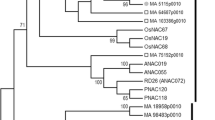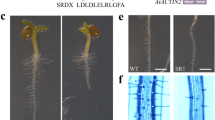Abstract
Lignin is an important biopolymer that is deposited in secondary cell walls of plant cells (e.g., tracheary elements) and in response to stresses such as wounding. Biosynthesis of lignin monomers occurs via the phenylpropanoid pathway, in which the enzyme 4-coumarate:CoA ligase (4CL) plays a key role by catalyzing the formation of hydroxycinnamoyl-CoA esters, subsequently reduced to the corresponding monolignols (hydroxycinnamoyl alcohols). 4CL is encoded by a family of four genes in Arabidopsis thaliana (At4CL1-At4CL4), which are developmentally regulated and co-expressed with other phenylpropanoid genes. We investigated in detail the wound-induced expression of At4CL1-At4CL4, and found that At4CL1 and At4CL2 mRNA accumulation follows biphasic kinetics over a period of 72 h, while At4CL4 expression is rapidly activated for a period of at least 12 h before declining. In order to localize cis-regulatory elements involved in the developmental and wound-induced regulation of the At4CL gene family members, At4CL promoter-beta-glucuronidase (GUS) reporter gene fusions were constructed and transferred into Arabidopsis plants. Analysis of these plants revealed that the promoter fragments direct discrete and distinct patterns of expression, some of which did not recapitulate expected patterns of wound-induced expression. The locations of regulatory elements associated with the At4CL2 gene were investigated in detail using a series of transgenic Arabidopsis plants containing promoter fragments and parts of the transcribed region of the gene fused to GUS. Positive and negative regulatory elements effective in modulating developmental expression or wound responsiveness of the gene were located both in the promoter and transcribed regions of the At4CL2 gene.







Similar content being viewed by others
Abbreviations
- 4CL:
-
4-Coumarate:CoA ligase
- RT-PCR:
-
Reverse transcription polymerase chain reaction
- GUS:
-
Beta-glucuronidase
- X-gluc:
-
5-Bromo-4-chloro-3-indolyl-β-d-glucuronide
References
Batard Y, Hehn A, Nedelkina S, Schalk M, Pallett K, Schaller H, Werck-Reichhart D (2000) Increasing expression of P450 and P450 reductase protein from monocots in heterologous systems. Arch Biochem Biophys 379:161–169
Becker D, Kemper E, Schell J, Masterson R (1992) New plant binary vectors with selectable markers located proximal to the left T-DNA border. Plant Mol Biol 20:1195–1197
Bell-Lelong DA, Cusumano JC, Meyer K, Chapple C (1997) Cinnamate-4 hydroxylase expression in Arabidopsis (regulation in response to development and the environment). Plant Physiol 113:729–738
Boter M, Ruiz-Rivero O, Abdeen A, Prat S. (2004) Conserved MYC transcription factors play a key role in jasmonate signaling both in tomato and Arabidopsis. Genes Dev 18:1577–1591
Cheong YH, Chang HS, Gupta R, Wang X, Zhu T, Luan S (2002) Transcriptional profiling reveals novel interactions between wounding, pathogen, abiotic stress, and hormonal responses in Arabidopsis. Plant Physiol 129:661–677
Clough SJ, Bent AF (1998) Floral dip: a simplified method for Agrobacterium mediated transformation of Arabidopsis thaliana. Plant J 16:735–743
Cutler S, Somerville C (2005) Imaging plant cell death: GFP-Nit1 aggregation marks an early step of wound and herbicide induced cell death. BMC Plant Biol 5:1–4
De Boer GJ, Testerink C, Pielage G, Nijkamp HJ, Stuitje AR (1999) Sequences surrounding the transcription initiation site of the Arabidopsis enoyl-acyl carrier protein reductase gene control seed expression in transgenic tobacco. Plant Mol Biol 39:1197–1207
Denekamp M, Smeekens SC (2003) Integration of wounding and osmotic stress signals determines the expression of the AtMYB102 transcription factor gene. Plant Physiol 132:1415–1423
Dixon RA, Paiva NL (1995) Stress-induced phenylpropanoid metabolism. Plant cell 7:1085–1097
Douglas CJ (1996) Phenylpropanoid metabolism and lignin biosynthesis: from weeds to trees. Trends Plant Sci 1:171–178
Douglas CJ, Hoffmann H, Schulz W, Hahlbrock K (1987) Structure and elicitor or uv-light stimulated expression of two 4-coumarate:CoA ligase genes in parsley. EMBO J 6:1189–1195
Douglas CJ, Hauffe KD, Ites-Morales ME, Ellard M, Paszkowski U, Hahlbrock K, Dangle JL (1991) Exonic sequences are required for elicitor and light activation of plant defense gene but promoter sequences are sufficient for tissue specific expression. EMBO J 10:1767–1775
Ehlting J, Büttner D, Wang Q, Douglas CJ, Somssich IE, Kombrink E (1999) Three 4-coumarate:coenzyme A ligases in Arabidopsis thaliana represent two evolutionarily divergent classes in angiosperms. Plant J 19:9–20
Ellard M, Douglas C (1996) Role of jasmonates in the elicitor and wound-inducible expression of defense genes in parsley and transgenic tobacco. Plant Physiol 112:183–192
Farmer E, Johanson R, Ryan C (1992) Regulation of expression of proteinase inhibitor genes by methyl jasmonate and jasmonic acid. Plant Physiol 98:995–1002
Feldbrügge M, Sprenger M, Hahlbrock K, Weisshaar B (1997) PcMYB1, a novel plant protein containing a DNA-binding domain with one MYB repeat, interacts in vivo with a light-regulatory promoter unit. Plant J 11(5):1079–1093
Gidekel M, Jimenez B, Herrera-Estrella L (1996) The first intron of the Arabidopsis thaliana gene coding for elongation factor 1 β contains an enhancer-like element. Gene 170:201–206
Gowik U, Burscheidt J, Akyildiz M, Schlue U, Koczor M, Streubel M, Westhoff P (2004) cis-Regulatory elements for mesophyll-specific gene expression in the C4 plant Flaveria trinervia, the promoter of the C4 phosphoenolpyruvate carboxylase gene. Plant Cell 5:1077–1090
Hahlbrock K, Scheel D (1989) Physiology and molecular biology of phenylpropanoid metabolism. Ann Rev Plant Phys Plant Mol Bio 40:347–369
Hajdukiewicz P, Svab Z, Maliga P (1994) The small, versatile pPZP family of Agrobacterium binary vectors for plant transformation. Plant Mol Biol 25:6989–6994
Hamberger B, Hahlbrock K (2004) The 4-coumarate:CoA ligase gene family in Arabidopsis thaliana comprises one rare, sinapate-activating and three commonly occurring isoenzymes. Proc Natl Acad Sci USA 101:72209–72214
Hao D, Ohme-Takagi M, Sarai A (1998) Unique mode of GCC-box recognition by the DNA-binding domain of ethylene-responsive element-binding factor (ERF domain) in plant. J Biol Chem 273:26857–26861
Hara K, Yagi M, Kusano T, Sano H (2000) Rapid systemic accumulation of transcripts encoding a tobacco WRKY transcription factor on wounding. Mol Gen Genet 263:30–37
Hauffe KD, Paszkowski U, Schulze-Lefert P, Hahlbrock K, Dangl JL, Douglas CJ (1991) A parsley 4CL-1 promoter fragment specifies complex expression patterns in transgenic tobacco. Plant Cell 3:5435–5443
Hauffe KD, Lee SP, Subramaniam R, Douglas CJ (1993) Combinatorial interactions between positive and negative cis-acting elements control spatial patterns of 4CL1 expression in transgenic tobacco. Plant J 4:235–253
He G, Tarui Y, Iino M (2005) A novel receptor kinase involved in jasmonate-mediated wound and phytochrome signaling in maize coleoptiles. Plant Cell Physiol 46:6870–6883
Higo K, Ugawa Y, Iwamoto M, Korenaga T (1999) Plant cis-acting regulatory DNA elements (PLACE) database. Nucleic Acids Res 27:1297–1300
Ito T, Sakai H, Meyerowitz E (2003) Whorl-specific expression of the SUPERMAN gene of Arabidopsis is mediated by cis elements in the transcribed region. Cur Biol 13:171524–1715230
Jefferson RA (1987) Assaying chimeric genes in plants: the GUS gene fusion system. Plant Mol Bio Rep 5:387–405
Jin H, Cornineill E, Bailey P, Parr A, Mehrtens F, Jones J, Tonelli C, Weisshaar B, Martin C (2000) Transcriptional repression by AtMYB4 controls production of UV-protecting sunscreens in Arabidopsis. EMBO J 19:6150–6161
Karim S, Lundh D, Holmström K, Mandal A, Pirhonen M (2005) Structural and functional characterization of AtPTR3, a stress-induced peptide transporter of Arabidopsis. J Mol Model 11:3226–3236
Lee D, Ellard M, Wanner LA, Davis KR, Douglas CJ (1995) The Arabidopsis thaliana 4-coumarate:CoA ligase (4CL) gene: stress and developmentally regulated expression and nucleotide sequence of its cDNA. Plant Mol Biol 28:5871–5884
Logemann E, Parniske M, Hahlbrock K (1995) Modes of expression and common structural features of the complete phenylalanine ammonialyase gene family in parsley. Proc Natl Acad Sci USA 92:5905–5909
Meyer K, Shirley AM, Cusumano JC, Bell-Lelong DA, Chapple C (1998) Lignin monomer composition is determined by the expression of a cytochrome P450-dependent monooxygenase in Arabidopsis. Proc Natl Acad Sci USA 95:6619–6623
Meyer S, Lauterbach C, Niedermeier M, Barth I, Sjolund RD, Sauer N (2004) Wounding enhances expression of AtSUC3, a sucrose transporter from Arabidopsis sieve elements and sink tissues. Plant Physiol 134:684–693
Mizutani M, Ohta D, Sato R (1997) Isolation of a cDNA and a genomic construct encoding cinnamate 4 hydroxylase from Arabidopsis and its expression manner in planta. Plant Physiol 113:755–763
Narváez-Vásqueza J, Florin-Christensen J, Clarence AR (1999) Positional specificity of a phospholipase A activity induced by wounding, systemin, and oligosaccharide elicitors in tomato leaves. Plant Cell 11:2249–2260
Neustaedter DA, Lee SP, Douglas CJ (1999) A novel parsley 4CL1 cis-element is required for developmentally regulated expression and protein-DNA complex formation. Plant J 18:77–88
Ohi S, Hedrick S, Chory J, Lamb C (1990) Functional properties of a phenylalanine ammonia-lyase promoter from Arabidopsis. Plant Cell 2:837–848
Park HC, Kim ML, Kang YH, Jeon JM, Yoo JH, Kim MC, Park CY, Jeong JC, Moon BC, Lee JH, Yoon HW, Lee SH,Chung WS, Lim CO, Lee SY, Hong JC, Cho MJ (2004) Pathogen- and NaCl-induced expression of the SCaM-4 promoter is mediated in part by a GT-1 box that interacts with a GT-1-like transcription factor. Plant Physiol 135:2150–2161
Preston J, Wheeler J, Heazlewood J, Li S, Parish R (2004) AtMYB32 is required for normal pollen development in Arabidopsis thaliana. Plant J 40:6979–6995
Raes J, Rohde A, Christensen JH, Van de Peer Y, Boerjan W (2003) Genome-wide characterization of the lignification toolbox in Arabidopsis. Plant Physiol 133:1051–1071
Reymond P, Weber H, Damond M, Farmer EE (2000) Differential gene expression in response to mechanical wounding and insect feeding in Arabidopsis. Plant Cell 12:707–719
Romeis T, Piedras R, Zhang S, Klessig DF, Hirt H, Jones JDG (1999) Rapid Avr9- and Cf9-dependent activation of MAP kinases in tobacco cell cultures and leaves: convergence of resistance gene, elicitor, wound, and salicylate responses. Plant Cell 11:273–287
Rose A, Meier I, Wienand U (1999). The tomato I-box binding factor LeMYBI is a member of a novel class of Myb-like proteins. Plant J 20:641–652
Rushton PJ, Reinstädler A, Lipka V, Lippok B, Somssich IE (2002) Synthetic plant promoters containing defined regulatory elements provide novel insights into pathogen- and wound-induced signaling. Plant Cell 14:749–762
Sakai H, Honma T, Aoyama T, Sato S, Kato T, Tabata S, Oka A (2001) ARR1, a transcription factor for genes immediately responsive to cytokinins. Science 294:1519–1521
Schaller F (2001) Enzymes of the biosynthesis of octadecanoid-derived signaling molecules. J Exp Bot 52:11–23
Schmelzer E, Kruger-Lebus S, Hahlbrock K (1989) Temporal and spatial pattern of gene expression around sites of attempted fungal infection in parsley leaves. Plant Cell 1:992–1001
Sprenger-Haussels M, Weisshaar B (2000) Transactivation properties of parsley proline-rich bZIP transcription factors. Plant J 22:1–8
Sugimoto K, Takeda S, Hirochika H (2003) Transcriptional activation mediated by binding of a plant GATA-type zinc finger protein AGP1 to the AG-motif (AGATCCAA) of the wound-inducible Myb gene NtMyb2. Plant J 36:4550–4564
Truernit E, Schmid J, Epple P, Illig J, Sauer N (1996) The sink-specific and stress-regulated Arabidopsis STP4 gene: enhanced expression of a gene encoding a monosaccharide transporter by wounding, elicitors, and pathogen challenge. Plant Cell 8:2169–2182
Turner JG, Ellis C, Devoto A (2002) The jasmonate signal pathway. Plant Cell 14:S153–S164
Zhang SH, Lawton MA, Hunter T, Lamb CJ (1994) Atpk1, a novel ribosomal protein kinase gene from Arabidopsis: I. Isolation, characterization, and expression. J Biol Chem 269:17586–17592
Acknowledgements
We thank Dr. Erich Kombrink, Max-Planck Institute for Plant Breeding Research, Cologne, Germany for the At4CL1::GUS and At4CL3::GUS lines and Ali Samaeian, Nahid Delroba, and Zahra Kazemi for technical assistance. BMS was partially supported by a fellowship from the Ministry of Science and Technology, Iran through Tarbiat Modarres University. This work was supported by a Discovery Grant from the Natural Sciences and Engineering Research Council (NSERC) of Canada to CJD.
Author information
Authors and Affiliations
Corresponding author
Additional information
An erratum to this article can be found at http://dx.doi.org/10.1007/s00425-006-0377-y
Rights and permissions
About this article
Cite this article
Soltani, B.M., Ehlting, J., Hamberger, B. et al. Multiple cis-regulatory elements regulate distinct and complex patterns of developmental and wound-induced expression of Arabidopsis thaliana 4CL gene family members. Planta 224, 1226–1238 (2006). https://doi.org/10.1007/s00425-006-0296-y
Received:
Accepted:
Published:
Issue Date:
DOI: https://doi.org/10.1007/s00425-006-0296-y




